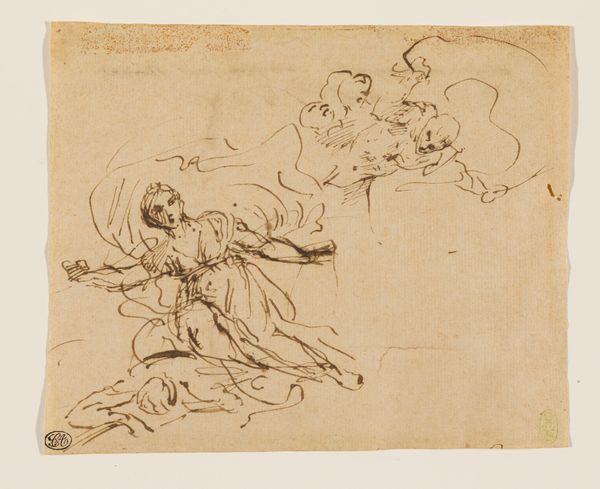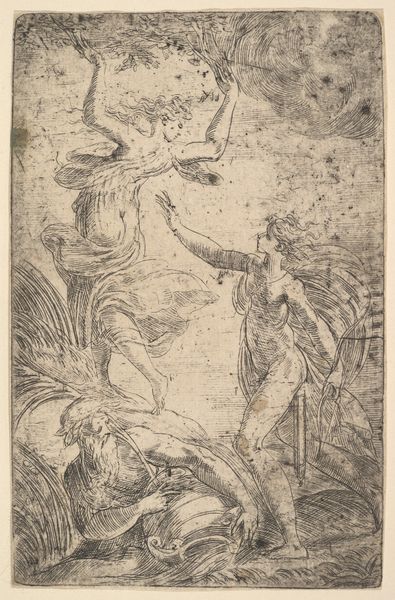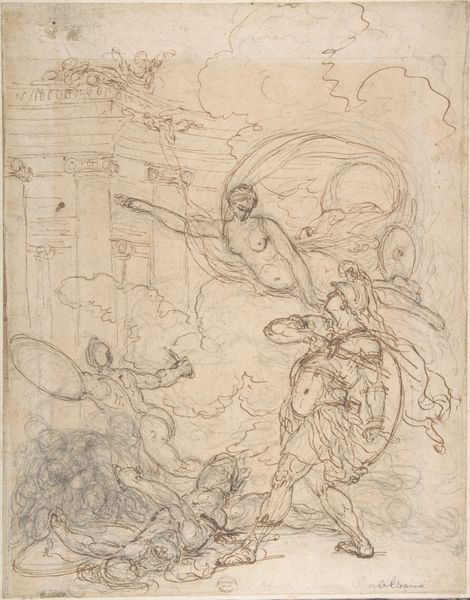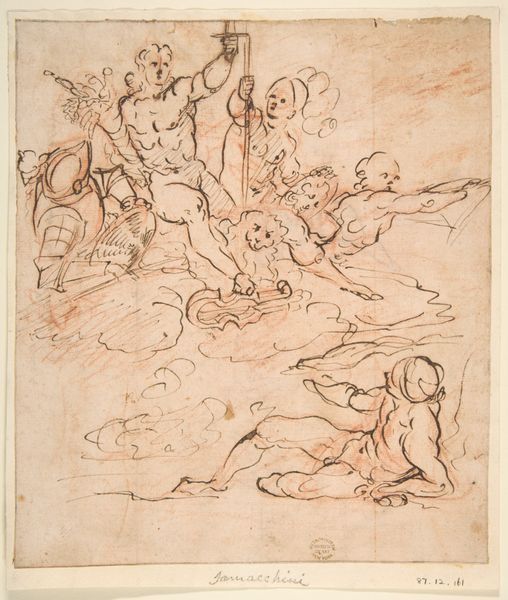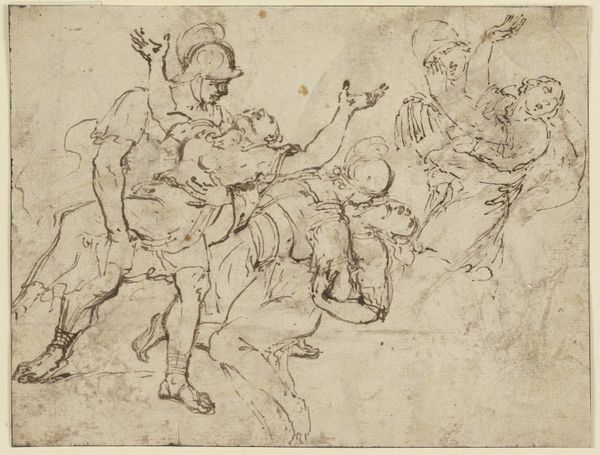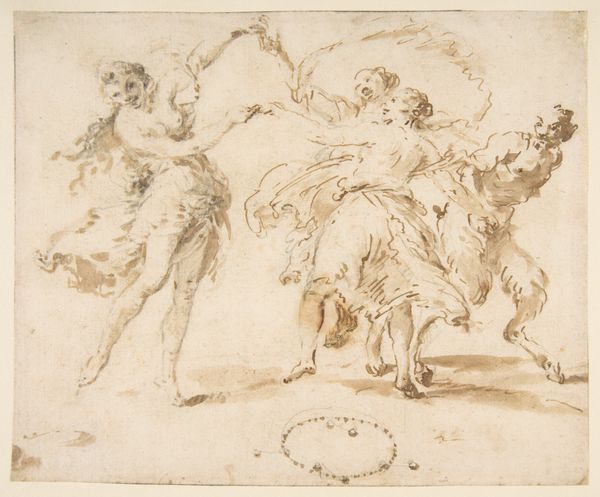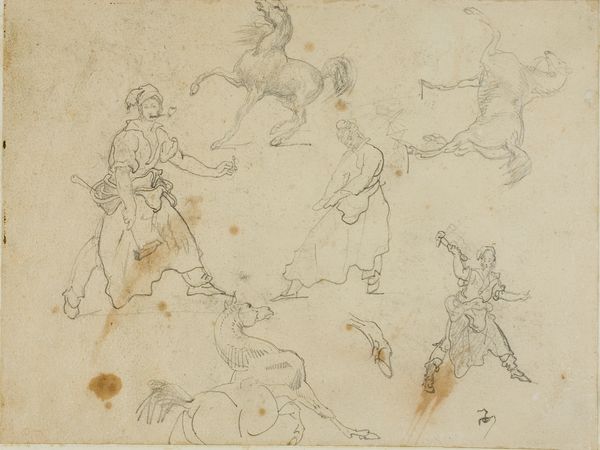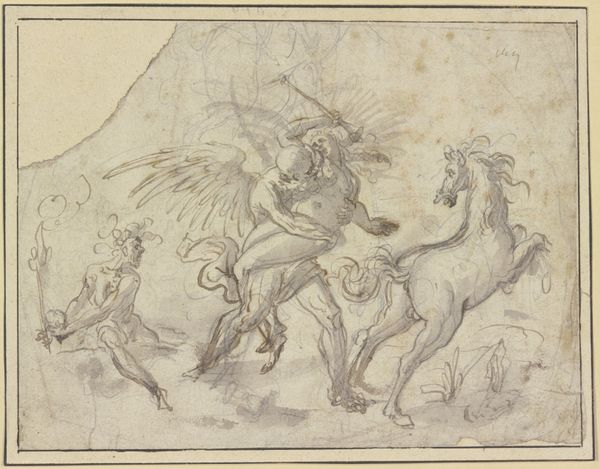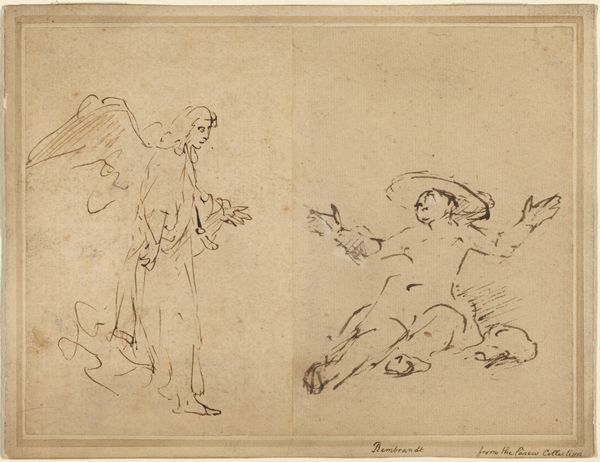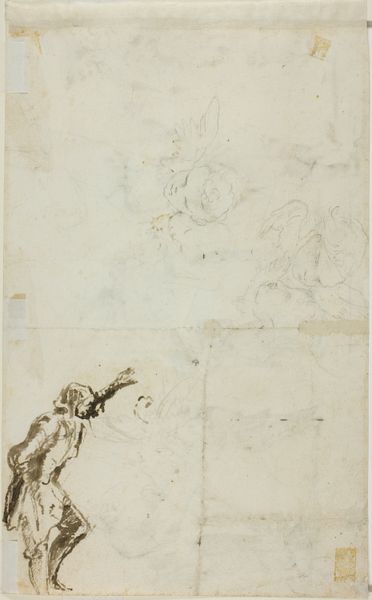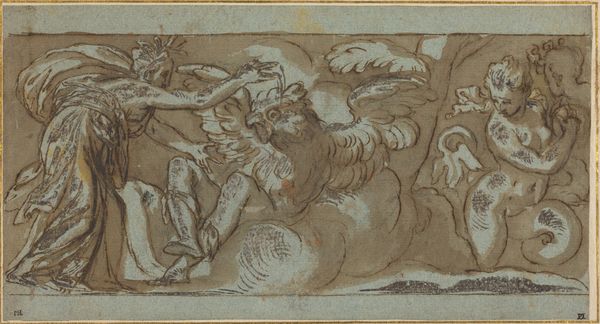
drawing, paper, pencil
#
drawing
#
baroque
#
etching
#
figuration
#
paper
#
pencil
#
history-painting
Dimensions: 211 mm (height) x 192 mm (width) (bladmaal)
Editor: We are looking at “The Miracle of St Agnes,” a pencil, pen and brown ink drawing on paper by Alessandro Algardi, created sometime between 1598 and 1654. The composition is really dynamic; the figures are full of movement and emotion. What elements of this drawing stand out to you? Curator: The vitality inhering in this drawing certainly seizes the eye. I am particularly interested in the linear construction of the piece. Note the artist’s fluid use of line, rapidly describing form and suggesting movement, typical of the Baroque. Do you observe how Algardi leverages hatching and cross-hatching? Editor: Yes, the cross-hatching creates volume and shadow. Is the sketchy quality typical for a preparatory drawing? Curator: Indeed. Consider this not as a finalized piece but a study, an exploration of form and composition. Focus on the negative space as it is equally important. Observe the gestural quality of the lines – see how they almost dance across the surface, suggesting the figures' emotional states, their fervor. Do you perceive this dynamism as contributing to the work's overall expressive quality? Editor: I do. I can almost feel the saint's emotion as the angel arrives. But does this expressive style also serve a functional purpose for Algardi, perhaps related to the planned final artwork? Curator: Absolutely. The drawing's loose and expressive character allowed Algardi to quickly capture and refine his ideas. Line work isn't merely representational but rather a system of signs and gestures in motion that allows us access to Algardi's method and mind. The baroque favors strong diagonals, is there anything striking? Editor: The angel is a prominent diagonal which increases the action in this compact scene! Thinking about the artist's process, it makes me appreciate the artwork. Curator: Precisely. Algardi uses minimal means to maximal effect and to engage the viewer with complex feeling.
Comments
statensmuseumforkunst almost 2 years ago
⋮
The drawing was first published by Minna Heimbürger, who also noticed the relationship to the relief on the high altar of the Pamphilj church of S. Agnese in Agone (Piazza Navona), Rome, which was commissioned from Algardi shortly before his death. According to Bellori, he “fece più di un modello per la tavola grande di marmo che egli doveva fare... espressovi Christo a sedere nell’aria e la Santa ginocchione che lo prega con braccia aperte, mentre l’angelo additta l’impuro giovine soffocato in terra del Demonio”.[1] No such models are known, but it is clear from the sources that one of them was selected for execution.[2] After Algardi’s death a full-scale model in stucco was made by his pupils Domenico Guidi and Ercole Ferrata. Despite the purchase of marble in 1654 the idea for carving this large altarpiece was abandoned and in 1660 Pope Alexander VII gave the stucco model to the Oratorio dei Filippini, Rome, where it can still be seen today. Although the drawing appears to be a study for the lower part of the relief, Jennifer Montagu doubts that there is a direct relationship. She finds it impossible to imagine that Algardi could ever have contemplated a square altarpiece, and she also has difficulty accepting it as a partial study, since the drawn composition does not make allowance for the upper part of the composition nor for the means to unite the two sections. She accordingly considers it more likely that the drawing might have been for one in a series of reliefs of this format to decorate the lower church, together with the reliefs of St Constantia’s vision of St Agnes (Palazzo Venezia, Rome)[3] and St Agnes led to martyrdom, the latter carved by Giovanni Buratti, but which Montagu thinks must be based on a design by Algardi.[4] She suggests that when this project was abandoned Algardi returned to the scene of the miracle and converted it into a format suitable for a high altar. In the altarpiece the figures were reversed to obtain equilibrium, and in order to make the protagonists more recognisable the devil was given bat’s wings and St Agnes’s emblem, the lamb, was added. The architectural setting, also comparable to the background of the Constantia relief, was retained, however. Neumann dates the drawing to the beginning of the work in S. Agnese, around 1651/52, and Vitzthum has observed that it displays the fine and elegant handling of line that Algardi had inherited from Ludovico Carracci and which he maintained throughout his entire career. It is, however, also clear that Algardi’s figures have gained in volume and that the line pattern is affected by drawings by Cortona, with whom he had been in close touch since the papacy of Urban VIII (1626-1644). Notes: 1 Bellori 1976, p. 413. 2 Montagu 1985, vol. 2, pp. 351-352. 3 Montagu 1985, vol. 2, p. 356, cat. no. 49.C.2., fig. 139. 4 Montagu 1985, vol. 2, pp. 350-351, cat. no. A.44. Bibliography: Heimbürger 1970, pp. 216-219, pl. XXV; Vitzthum 1970, p. 41, fig. 29; Montagu 1985, vol. 1, pp. 153-154, fig. 167, vol. 2, p. 352, under cat. no. 45.L.B.1, p. 479, no. 19; Neumann 1985, pp. 283-284, cat. no. 14.4; Carofano 1994, pp. 72-73; Johnston in Montagu ed. 1999, pp. 306-309, cat. no. 103, ill.
Join the conversation
Join millions of artists and users on Artera today and experience the ultimate creative platform.
